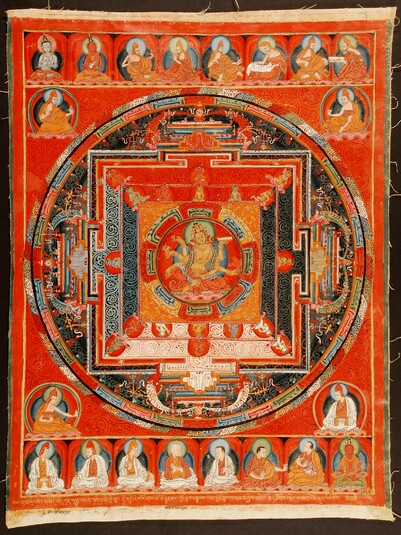
Item: Mandala of Vasudhara (Buddhist Deity) - (1 face, 6 hands)
| Origin Location | Tibet |
|---|---|
| Date Range | 1500 - 1599 |
| Lineages | Sakya, Ngor (Sakya) and Buddhist |
| Material | Ground Mineral Pigment on Cotton |
| Collection | Private |
Classification: Deity
Appearance: Peaceful
Gender: Female
Vasudhara Mandala.
"Vasudhara, yellow, with one face and six hands; in a manner happily seated at play. The first right hand is in a gesture of supreme generosity, the second 'raining jewels,' the third with the hand in a gesture accompanying singing. The first left holds an abundant vase, the second a sheaf of grain, the third [holds] the Prajnaparamita text; adorned with all jewel ornaments." This form of Vasudhara arises from the Togpa Chungwa and the Vajravali text of Abhayakaragupta.
Painted in the Ngor Monastery style of Tsang Province, Tibet, the individualized depictions of the lineage teachers in the top and side registers indicates that the painting, created by Tibetan artists, is a second or third generation removed from the original Newar creations of the 15th century and earlier. The Newar artists were partial to generic faces for deities and human figures. This painting gives individual characteristics to the figures and is a good example of Tibetan appropriation of Newar style.
Jeff Watt 2-2008
Front of Painting
English Translation of Inscription: [Auspicious verses written across the bottom front]
Reverse of Painting
Special Features: (Printed script (Uchen), includes "Om Ah Hum" inscription)
Subject: Female Deities - Yellow
Buddhist Deity: Vasudhara, Six Hands
Buddhist Deity: Vasudhara (Mandala)
Buddhist Deity: Vasudhara Main Page
Buddhist Deity: Vasudhara (Masterworks)
Buddhist Deity: Vasudhara (19 Deities)
Buddhist Deity: Vasudhara Iconography
Buddhist Deity: Vasudhara Art History



